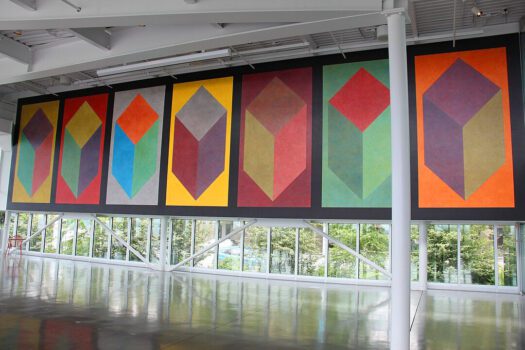What Was Sol LeWitt Known For
When discussing the trajectory of modern and contemporary art, the name Sol LeWitt stands as a towering figure, a master of the conceptual, a pioneer of the minimal, and a provocateur who radically redefined the nature of authorship and the role of the artist. From his deceptively simple wall drawings to his intricate three-dimensional structures, LeWitt’s work was not just about visual spectacle but also about ideas, systems, and a new way of seeing and understanding art. In this deep dive, we’ll explore who Sol LeWitt was, the cost and scale of his art, his iconic techniques, the ideas that shaped his practice, and the legacy that endures through hundreds of works that continue to influence generations.
Who Was Sol LeWitt?
Sol LeWitt (1928–2007) was an American artist known for his contributions to Minimalism and Conceptual Art. Born in Hartford, Connecticut, he studied at Syracuse University and later served in the U.S. Army during the Korean War. After his military service, he moved to New York City, where he worked as a graphic designer and later as a night receptionist at the Museum of Modern Art (MoMA). This proximity to the art world, and to influential figures like Dan Flavin, Robert Ryman, and Lucy Lippard, helped fuel his intellectual and artistic development.
LeWitt’s early artistic journey mirrored the Abstract Expressionist landscape of the 1950s, but he would soon diverge radically from the gestural and emotive expressions of that movement. He sought order, clarity, and logic, a stark contrast to the chaotic energy of Jackson Pollock or Willem de Kooning.
What Was Sol LeWitt Known For?
LeWitt is most famously known for being one of the founders of Conceptual Art and Minimalism. His breakthrough came in the 1960s when he began exploring the idea that the idea or concept behind the artwork was more important than the final object itself.
In his seminal 1967 essay, Paragraphs on Conceptual Art, LeWitt famously wrote:
“The idea becomes a machine that makes the art.”
This revolutionary statement turned the art world on its head. Instead of focusing on craftsmanship, aesthetic beauty, or personal expression, LeWitt emphasized logic, systems, and instructions. Art could now be generated by a set of directives, what some might call a score or script. The artist became more of an architect than a builder.
How Does Sol LeWitt Make His Artwork?
One of the most fascinating aspects of LeWitt’s art is that he often did not create the final works himself. Instead, he would produce detailed written instructions or diagrams that could be executed by assistants, students, or museum staff. This was especially true for his famed Wall Drawings, which could be recreated in different locations with exacting precision and sometimes with slight variations based on the interpretation of the instructions.
For example, Wall Drawing #118 might read:
“On a wall surface, any continuous stretch of wall, using a hard pencil, place fifty points at random. The points should be evenly distributed over the area of the wall. All of the points should be connected by straight lines.”
These directives are algorithmic in nature. The beauty of the piece lies in the process, the realization, and the open-endedness of its execution.
What Is Sol LeWitt’s Most Famous Artwork?
Sol LeWitt created hundreds of works, but several stand out as iconic:
Wall Drawing #260 (1975) – This work exemplifies his conceptual approach. It includes simple geometric shapes rendered with straight lines and solid forms, inviting viewers to consider not just the outcome, but the logic behind it.
Incomplete Open Cubes (1974) – A series of sculptures that systematically explores the permutations of incomplete cube structures. This work is both mathematically rigorous and visually poetic.
Wall Drawing #1136 – Installed at MASS MoCA, this is a multicolored, large-scale work that fills an entire room. It’s one of the most elaborate and vibrant examples of his wall drawing philosophy.
Splotches, Scribbles, and Stars (1990s–2000s) – Later in his career, LeWitt moved toward more expressive, painterly forms with bright colors and dynamic shapes. These works retained conceptual rigor but embraced a freer aesthetic language.
Each of these works showcases his desire to blur the lines between creator and executor, between idea and object, and between artist and viewer.
How Many Artworks Does Sol LeWitt Have?
The Sol LeWitt estate has documented over 1,200 wall drawings, as well as hundreds of sculptures (which he called “structures”), prints, gouaches, and artist’s books. His total body of work likely exceeds 2,000 individual pieces, depending on how one categorizes variations, studies, and editions.
Notably, many of LeWitt’s works are site-responsive, meaning that they adapt based on the dimensions and context of the location. Because of this, a single conceptual work may exist in multiple physical incarnations, each considered an authentic representation of the idea.
What Art Style Is Sol LeWitt Associated With?
Sol LeWitt is most closely associated with two major movements:
Minimalism – A movement that emphasizes simplicity, repetition, and the use of geometric forms. LeWitt’s early sculptures (or “structures”), often composed of white-painted open cubes, are paragons of minimalist thought.
Conceptual Art – Here, the emphasis shifts from the physical object to the underlying concept. LeWitt’s wall drawings, with their instructions-as-art, are the blueprint of this style.
Though these two labels are most common, LeWitt’s work also touches on Systems Art, Serial Art, and Process Art, all of which value planning, logic, and algorithms over emotional expression.
What Materials Did Sol LeWitt Use?
LeWitt’s materials varied significantly over the course of his career, depending on the form of the work:
Wall Drawings
Pencil
Colored pencil
Crayon
Ink
Acrylic paint
Washes and gouache
Graphite
Washy ink brushes and scribbles (in later years)
Structures (Sculptures)
Painted wood
Concrete blocks
Metal (aluminum, steel)
Fiberglass
Plexiglas
LeWitt chose his materials carefully, often favoring those that emphasized clarity, durability, and architectural purity. His white painted wood sculptures, for instance, are notable for their precision and crisp geometry.
How Much Does Sol LeWitt Art Cost?
The value of Sol LeWitt’s artwork varies greatly depending on the medium, provenance, and scale. As of recent auctions and private sales, here are some price ranges:
Wall Drawings (with certificate) – $250,000 to $1.5 million
Note: The certificate of authenticity is crucial. The physical drawing can be destroyed and reinstalled, but the certificate carries the actual value and authorship.Sculptures (“Structures”) – $200,000 to $900,000+ depending on size and edition
Works on Paper (Gouaches, Drawings) – $20,000 to $200,000
Prints (Serigraphs, Lithographs) – $2,000 to $50,000
Auction houses like Christie’s, Sotheby’s, and Phillips have featured LeWitt’s work prominently, and collectors prize it for both its conceptual significance and market stability.
How Famous Is Sol LeWitt?
Within the art world, Sol LeWitt is a colossal figure. He is widely regarded as one of the most influential artists of the late 20th century. Museums and institutions that hold major collections or installations of his work include:
The Museum of Modern Art (MoMA), New York
The Whitney Museum of American Art
The Tate Modern, London
Centre Pompidou, Paris
MASS MoCA, Massachusetts – home to a major permanent installation
LeWitt’s reputation extends beyond art professionals. His public sculptures are installed in cities around the world, making his work accessible to everyday viewers. His influence also spans across disciplines, affecting architecture, design, mathematics, and education.
Sol LeWitt Legacy and Influence
Sol LeWitt’s impact is hard to overstate. His approach has inspired not just other visual artists, but also musicians, designers, architects, and writers. The notion that a set of instructions can be the artwork itself was radical and remains provocative today, especially in the age of digital art and NFTs.
He also established a new model for collaborative authorship, opening up the process of making art to teams, students, and fabricators, while still maintaining conceptual control. In this way, LeWitt paved the way for contemporary practices that value collaboration, process, and open-source creativity.
Even after his death in 2007, LeWitt’s studio and estate continue to manage his legacy through installations, publications, and educational programs. His influence shows no signs of waning.
Sol LeWitt didn’t just make art, he redefined what art could be. In a world that often equates artistic genius with individual expression, LeWitt turned the spotlight onto systems, logic, and ideas. By doing so, he empowered others to become part of the creative act, democratized the production of art, and invited us all to think a little more deeply about where creativity truly begins.
His work isn’t just a visual experience; it’s an intellectual, spatial, and even philosophical one. Whether viewed on a gallery wall or enacted through a set of written instructions, Sol LeWitt’s art continues to resonate because it embodies both precision and possibility.
In a sense, LeWitt left us not just with works of art, but with blueprints for thought.




